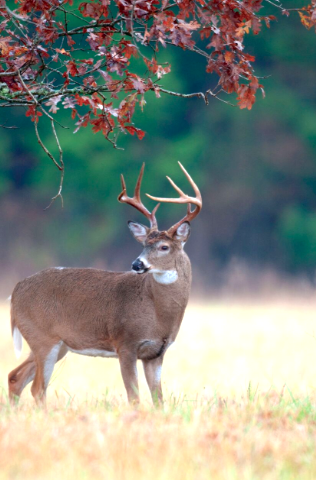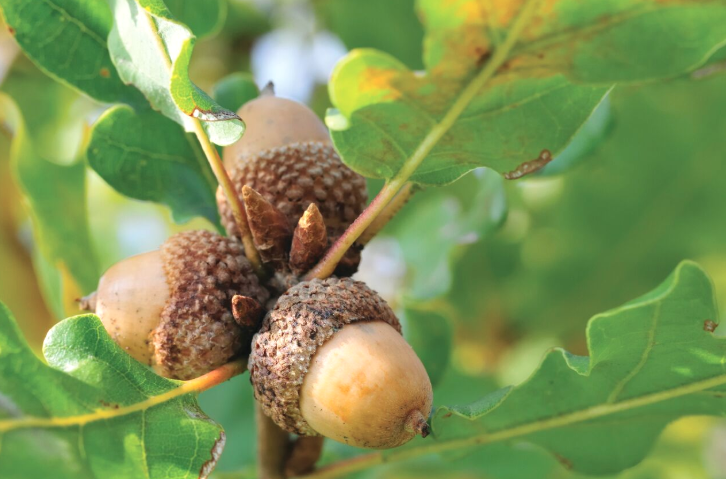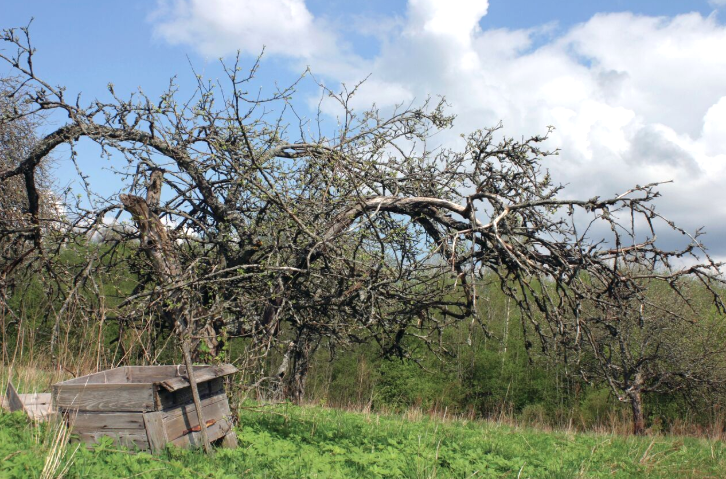Ah, the magic of early-fall whitetail hunting.
We’re probably talking archery hunting, but the occasional muzzleloader season comes into play too, and even a few rifle hunts. You know the story: After some careful late-summer and early-fall scouting, you have the local deer all figured out. They’re hitting this hay meadow, that alfalfa field, a clover food plot over here or a browse-rich clearcut edge over there just like clockwork.
Even if the local cornfield or soybean patch gets harvested, you know what you’re going to do. All is good with the world: Wait for the right wind, sneak in during midafternoon and settle in to a blind or climb up and strap in to a pre-set treestand and wait for your winter venison to mosey right along.
Then the wheels come off the track.
No whitetails show their faces during shooting hours. The wind was right, your stands well-placed, your approach as quiet as a church mouse. You repeat your efforts for a couple of days, but nothing’s really happening.
What destroyed all the potential magic? If your local and well-scouted whitetails are suddenly forsaking still-green hay meadows, lush alfalfa fields or fresh-harvested small grain fields in early fall, mast is a likely culprit.
Managing the mast challenge comes down to three factors: realizing why hard mast (focusing mainly on acorns) is such a whitetail magnet; understanding the kinds of oak trees that produce preferred mast; and identifying sound hunting strategies for turning the mast challenge into a win. Soft mast is an additional topic that deserves attention from early-season whitetail hunters.
Power Food
Hard mast – usually in the form of acorns — is whitetail power food that deer will focus on when available, ignoring almost all other forage. Why would a whitetail forsake other high-value food sources?
Like humans, whitetails need balanced nutrition. The building blocks are protein, carbohydrates and fats. While acorns are low in protein, they are exceedingly high in carbohydrates and fats. Those elements help put mass and fat on deer, and that prepares them for winter. And if whitetail eat enough acorns (which they will do), they will get their required intake of protein as well.
In short, acorns are a win-win-win food. Acorns are simply a natural food that whitetails evolved with and flock to. They are autumn’s perfect whitetail food.
Understanding Oaks
Oaks fall within the beech tree family, under the genus name Quercus. There are two basic classes of oak tree that the deer hunter needs to know – white oaks and red oaks. All oaks drop acorns, and whitetails will eat acorns from any kind of oak tree, but deer do have preferences.
White oak acorns are by far the whitetail’s favorite. Quercus alba, or the white oak itself, is both widespread and well known. White oak acorns are low in tannins, which means they are not bitter-tasting and actually taste palatable, even to humans. Peel off the shell and try one sometime!
 Oaks within the white oak sector produce acorns every year, which means the tree flowers, produces acorns and drops them in one spring-to-fall cycle. But not all years are created equal – one year may see a tree produce a bumper crop, the next year next-to-nothing.
Oaks within the white oak sector produce acorns every year, which means the tree flowers, produces acorns and drops them in one spring-to-fall cycle. But not all years are created equal – one year may see a tree produce a bumper crop, the next year next-to-nothing.
Besides the classic white oak itself, other trees in the white oak group include the swamp white oak, bur oak, post oak, chestnut oak and chinkapin oak.
While higher in tannins and generally not as tasty as white-oak-style acorns, red oak (Quercus rubra) acorns provide important whitetail forage too. Good nutrition trumps flavor.
Oaks within the red oak sector produce acorns every other year, meaning flowers bloom one spring acorns form and grow through that fall and hang on all winter, then finish developing the next summer and drop that fall. Interestingly, red oaks can have two year-classes of acorns on the tree at the same time.
Beside the namesakes, northern red oak and southern red oak, other trees in the red oak group include the black oak, pin oak, turkey oak, blackjack oak and water oak.
Hunting Strategies
Hunting starts with scouting, and if you have abundant oaks in your hunting area, it’s smart to launch a late-summer oak-scouting mission to see what might be happening on the trees and where the acorn action might occur.
Take a nonchalant midday wander. That won’t bother the local deer much if at all. If lots of acorns are coming in a particular grove or woodlot, or on a certain ridge, this is even a good time to set a stand or two.
Whether you’re setting stands early or reacting to an acorn crop in-season, the key question is: Do you hunt right in the oaks, or on a travel corridor to or from them? It all depends on time of day.
One option is to set up right at the source: in the oaks themselves. That's why afternoon hunts in the oaks are great – get there plenty early, set up, settle in and be quietly waiting when the deer start moving.
Dawn hunts in the oaks can be tough, because the deer may already be there feeding when you arrive. Now is the time to hunt travel corridors coming out of the oaks. That said, don’t be afraid to move right into the oaks after a couple of hours. A mid-morning stand right in there among the acorns can be a fine place to arrow a hungry early-fall whitetail.
Soft Mast
Not all mast is hard. Soft mast is the other part of the mast equation. Soft mast often falls even earlier than hard mast and can be the key to connecting with an early-season whitetail.
If local meadows and hayfields are lightly used by deer, soft mast may be occupying the deer before last light and attracting them back into cover before first light. A three-step solution involves understanding the types of soft mast whitetails love, learning how to find it and mastering how to hunt it.
Identifying Soft Mast
Soft mast peaks as summer fades from the landscape but autumn delays its grip. Fruits and berries abound after a summer of warmth and rain. A few cool nights begin the process of ripening the juicy mast. Whitetails love something sweet, and the sugars in soft mast are a magnet.
Some of the best soft mast sources available and attractive to whitetails include:
Persimmons (Diospyros virginiana): Tree. Yellow to pale orange fruits, often with a blush of red or blue, abound. Found in the South and lower Midwest.
Plums (Prunus americana): Large shrub / small tree. Purple-yellow to red fruits grow juicy and thick in the South, Midwest and Plains.
Pears (Pyrus species): Tree. Pears are native to the Old World but readily pioneered North America thanks to orchard plantings.
Apples (Malus species): Tree. From green to yellow and red fruits, any old apple orchard is a deer haven in early fall. Another colonial import.
Crabapples (Malus species): Small tree. These wild North American natives bear red, yellow or purple fruits.
Chokecherries (Prunus virginiana): Large shrub / small tree. Produces red to purple or black fruit. Native to northern half of U.S. and southern Canada.
Pin Cherries (Prunus pensylvanica): Small tree / large shrub. Bright red fruit. Widespread from the Appalachians and New England across northern U.S and southern Canada.
Dogwood (Cornus species): Shrub / tree. Offers profuse small berries that are white, gray, blue or red. Subspecies are found everywhere.
Scouting Soft Mast
Get out before the opener and walk the edges of woodlands, wetlands, fields and meadows to find ripening fruits and berries. Another prime time to scout is spring turkey season, when most of these plants flower profusely; keep a logbook of locations, or ping the coordinates into your GPS.
Hunting Soft Mast
Think of soft mast as candy, not the main course. Keep your approach simple with these five concepts:
- Whitetails will hit soft mast on their way out to, or back in from, traditional feeding spots.
- Set up right there, in range of the ripe forage.
- Stay until midmorning.
- Be there by midafternoon.
- Use a ground blind if there aren't suitable trees to hang a stand in.
Conclusion
The deer have been hitting the green fields hard and then one day poof, the whitetails vanish. Or maybe they don’t come until after dark. What happened? One likely answer is that mast is dropping or ripe, and the deer have shifted their feeding focus.
If there's one menu item whitetails prefer more than their salad when autumn is still mild, it's high-carb, high-fat mast of both the hard and soft varieties. Embrace the mast challenge with a focused scouting and hunting plan, and sock away some early-season venison.
BONUS #1: Control the Mast Drop
If you own hunting property where you can manipulate the landscape, you might consider planting your own orchard. While Mother Nature determines the timetable for dropping mast on native plants, you can plant specific species to drop early and late to extend your hunting success. For example, Chestnut Hill Outdoors offers early- and late-dropping native persimmon trees. The early variety drops fruit September through October, while the late variety drops October through November. By planting both varieties in an area where you can hunt, you’ll ensure the deer will keep coming back for three-plus months. As a bonus, both varieties are grafted female trees, which means all trees produce fruit, unlike the fruitless male trees of native persimmons. Chestnut Hill has late-dropping apple and pear varieties, too, which will keep fruit on the ground in hunting season. Chestnut Hill is famous for their Dunstan Chestnut trees, which are blight resistant. These trees begin producing chestnuts at 3 to 5 years of age and chestnuts have a higher protein and carbohydrate count than oaks. For more information on establishing your own orchard, visit www.chestnuthilloutdoors.com. — Mark Olis
BONUS #2: Lasting Value
While soft mast comes and goes from the landscape relatively quickly, hard mast in the form of acorns lasts much longer and can provide good hunting much later in autumn and even into winter.
A good case-in-point here was Wisconsin’s firearms season last fall. While ample cornfields many still standing surrounded the Green County woodlots my boys and I were hunting, an afternoon walk revealed a bumper acorn crop and heavy deer use on one particular hillside.
That afternoon, I set up my son Ethan there, and he dropped a 5-pointer. Two mornings later, my boy Jeremiah shot his very first buck there — a sleek spike — that came snuffling through, vacuuming up acorns at 8:30 in the November sunshine. — Tom Carpenter








